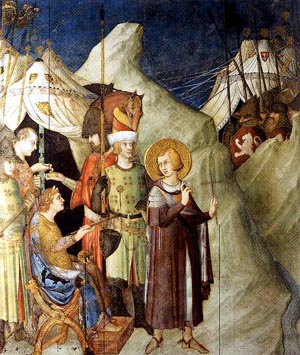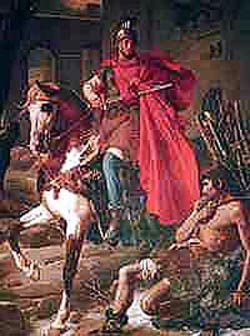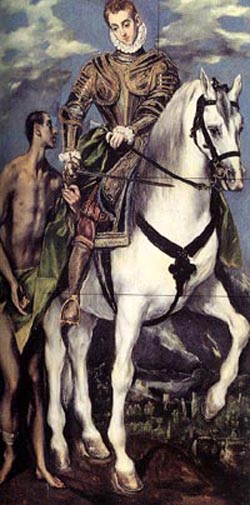 |
The Saint of the Day
St. Martin of Tours, November 11
Prof. Plinio Corrêa de Oliveira
Biographical selection:
"St. Martin’s mission was to complete the destruction of paganism, which had been driven from the towns by the martyrs but remained up to his time master of vast territories removed from the influence of the cities. All of Gaul heard from him.

St. Martin of Tours preaches the word of God throughout Gaul
|
"In all its provinces he overthrew the idols one after another, reduced the statues to powder, burnt or demolished all the temples, destroyed the sacred groves and all the haunts of idolatry. Martin, consumed with zeal for the House of God, was obeying none but the Spirit of God.
"Against the fury of the pagan population Martin’s only arms were the miracles he wrought, the visible assistance of the Angels sometimes granted to him, and, above all the prayers and tears he poured out before God, when the hard-heartedness of the people resisted the means by which Martin changed the face of the country.
"Where he found scarcely a Christian on his arrival, he left scarcely an infidel at his departure. The temples of the idols were immediately replaced by temples of the true God. For, says Sulpicius Severus, as soon as he had destroyed the houses of superstition, he built churches and monasteries. It is thus that all Europe is covered with sanctuaries bearing the name of St. Martin."
From The Liturgical Year by Dom Prosper Gueranger, O.S.B.
Comments of Prof. Plinio:
Dom Guéranger presented a first rate history of St. Martin of Tours. He went to the very heart of his mission, expounded it and analyzed it. It seems to me that its sociological aspect is the following:

St. Martin is most often depicted as a Roman soldier sharing his cloak with a beggar, above,
or as El Greco stylized him, below

|
In the Roman Empire the Catholic Religion conquered the cities more rapidly because of the vaster concentration of people in the urban centers. The evangelization was more successful and rapid because all the people were congregated together. Then the cities became the great focus of irradiation spreading the Catholic Religion. The cities were also the focus of the greater persecutions, and most of the martyrdoms took place in them.
Since the roads to the countryside were poor, people outside the cities lived isolated, far from each other, and the Catholic Religion did not reach them so easily. This was the reason why, even after the Christian Empire had been established in Rome and the great cities, paganism was still strong in the countryside. And this was the reason why St. Martin received the mission to destroy that paganism.
Pagus in Latin means village. From this came the name paganism, as synonymous with a village life, in the sense of a “hillbilly” backwoods life. The pagan was the primitive who still worshiped stones and groves instead of realizing that there is only one God, spiritual, immortal, King of all ages, and only one Jesus Christ, His Son, Our Lord the Savior, etc.
Therefore, St. Martin set out on a mission in which he was both the preacher who spread the Word of God, but also the warrior who destroyed the idols and the temples dedicated to the false gods. It is interesting to note that St. Augustine of Canterbury used to recommend that the pagan temples should not be destroyed. But here St. Martin did exactly the opposite, he destroyed the pagan temples. Naturally, the Saints had their different reasons. Most probably one reason was because the people in Britain could be attracted to the Catholic Church in those temples, which would then be purified for the practice of the true Faith. However, in France the temples were symbols that would invite the people to remain pagan. So, the great St. Martin spent a considerable part of his life preaching and destroying pagan temples.
If you look at the normal biographies of St. Martin, you will see that they generally don’t present this aspect shown by Dom Guéranger. They recount the famous case of St. Martin on horseback, stopping before a poor, cold beggar, and then tearing his mantle in half to share it with him. For a sentimental Catholic this episode summarizes the entire life of St. Martin.
I agree that it was good and noble to do that, but to take this as his whole life is to present a reality different from what actually happened. If it only demanded this kind of charity toward the poor to be a saint, we could leave aside every other concern and concentrate only on dividing mantles to give to the poor. It would be very easy. But this is not all that sanctity calls for. To present it as such is to distort the picture for persons and close them to the full reality of the lives of the saints. It is a poison, a kind of idolatry of sentimentality where there is no place for Catholic militancy. St. Martin, who was so saintly and had so many merits, including a great hatred for the pagan idols, certainly would likewise abhor this modern idol of sentimentality.
We might ask St. Martin to give us his zeal for the House of God, the Holy Catholic Church, and his efficiency in destroying idols. We should ask him to help us apply this spirit in fighting the idol of sentimental religiosity in our souls, so that we might truly understand the lives of the saints, follow their example, and become saints ourselves.


  | | Prof. Plinio Corrêa de Oliveira | |
The Saint of the Day features highlights from the lives of saints based on comments made by the late Prof. Plinio Corrêa de Oliveira. Following the example of St. John Bosco who used to make similar talks for the boys of his College, each evening it was Prof. Plinio’s custom to make a short commentary on the lives of the next day’s saint in a meeting for youth in order to encourage them in the practice of virtue and love for the Catholic Church. TIA thought that its readers could profit from these valuable commentaries.
The texts of both the biographical data and the comments come from personal notes taken by Atila S. Guimarães from 1964 to 1995. Given the fact that the source is a personal notebook, it is possible that at times the biographic notes transcribed here will not rigorously follow the original text read by Prof. Plinio. The commentaries have also been adapted and translated for TIA’s site.
|
Saint of the Day | Home | Books | CDs | Search | Contact Us | Donate

© 2002- Tradition in Action, Inc. All Rights Reserved
|
 |

|